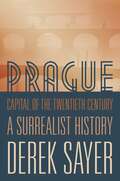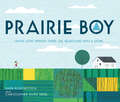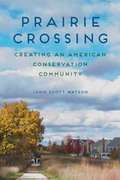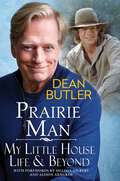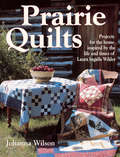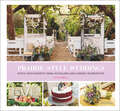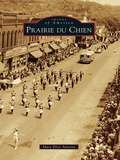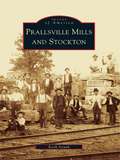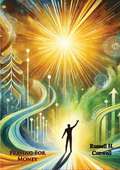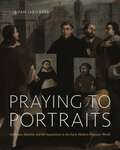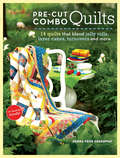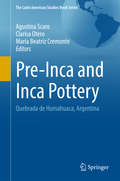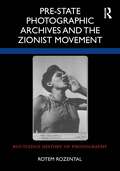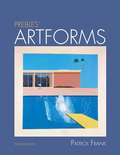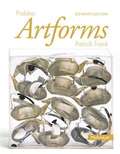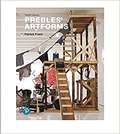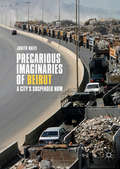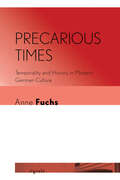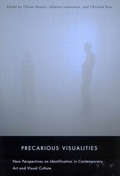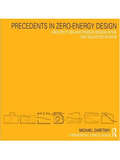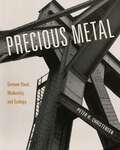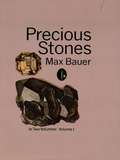- Table View
- List View
Prague, Capital of the Twentieth Century: A Surrealist History
by Derek SayerThe story of modernity told through a cultural history of twentieth-century PragueSetting out to recover the roots of modernity in the boulevards, interiors, and arcades of the "city of light," Walter Benjamin dubbed Paris "the capital of the nineteenth century." In this eagerly anticipated sequel to his acclaimed Coasts of Bohemia: A Czech History, Derek Sayer argues that Prague could well be seen as the capital of the much darker twentieth century. Ranging across twentieth-century Prague's astonishingly vibrant and always surprising human landscape, this richly illustrated cultural history describes how the city has experienced (and suffered) more ways of being modern than perhaps any other metropolis.Located at the crossroads of struggles between democratic, communist, and fascist visions of the modern world, twentieth-century Prague witnessed revolutions and invasions, national liberation and ethnic cleansing, the Holocaust, show trials, and snuffed-out dreams of "socialism with a human face." Yet between the wars, when Prague was the capital of Europe's most easterly parliamentary democracy, it was also a hotbed of artistic and architectural modernism, and a center of surrealism second only to Paris.Focusing on these years, Sayer explores Prague's spectacular modern buildings, monuments, paintings, books, films, operas, exhibitions, and much more. A place where the utopian fantasies of the century repeatedly unraveled, Prague was tailor-made for surrealist André Breton's "black humor," and Sayer discusses the way the city produced unrivaled connoisseurs of grim comedy, from Franz Kafka and Jaroslav Hasek to Milan Kundera and Václav Havel. A masterful and unforgettable account of a city where an idling flaneur could just as easily be a secret policeman, this book vividly shows why Prague can teach us so much about the twentieth century and what made us who we are.
Prairie Boy: Frank Lloyd Wright Turns The Heartland Into A Home
by Barb RosenstockA Notable Social Studies Trade Book for Young People * A NSTA/CBC Best STEM BookFrank Lloyd Wright, a young boy from the prairie, becomes America's first world-famous architect in this inspirational nonfiction picture book introducing organic architecture -- a style he created based on the relationship between buildings and the natural world -- which transformed the American home.Frank Lloyd Wright loved the Wisconsin prairie where he was born, with its wide-open sky and waves of tall grass. As his family moved across the United States, young Frank found his own home in shapes: rectangles, triangles, half-moons, and circles. When he returned to his beloved prairie, Frank pursued a career in architecture. But he didn't think the Victorian-era homes found there fit the prairie landscape. Using his knowledge and love of shapes, Frank created houses more organic to the land. He redesigned the American home inside and out, developing a truly unique architecture style that celebrated the country's landscape and lifestyle. Author Barb Rosenstock and artist Christopher Silas Neal explore the early life and creative genius of architect Frank Lloyd Wright, highlighting his passion, imagination, and ingenuity.
Prairie Crossing: Creating an American Conservation Community
by John Scott WatsonCarved out of century-old farmland near Chicago, the Prairie Crossing development is a novel experiment in urban public policy that preserves 69 percent of the land as open space. The for-profit project has set out to do nothing less than use access to nature as a means to challenge America's failed culture of suburban sprawl. The first comprehensive look at an American conservation community, Prairie Crossing goes beyond windmills and nest boxes to examine an effort to connect adults to the land while creating a healthy and humane setting for raising a new generation attuned to nature. John Scott Watson places Prairie Crossing within the wider context of suburban planning, revealing how two first-time developers implemented a visionary new land ethic that saved green space by building on it. The remarkable achievements include a high rate of resident civic participation, the reestablishment of a thriving prairie ecosystem, the reintroduction of endangered and threatened species, and improved water and air quality. Yet, as Watson shows, considerations like economic uncertainty, lack of racial and class diversity, and politics have challenged, and continue to challenge, Prairie Crossing and its residents.
Prairie Man: My Little House Life & Beyond
by Dean ButlerCelebrating its 50th anniversary and still airing in the U.S. and around the world, Little House on the Prairie is one of the most cherished family dramas in television history, and this smart, candid memoir from beloved star Dean &“Almanzo&” Butler, who played Laura &“Half-Pint&” Ingalls&’ eventual husband, is a must-read for fans, filled with insider stories and anecdotes. Cast just before his twenty-third birthday, Dean Butler joined Little House on the Prairie halfway through its run, gaining instant celebrity and fans&’ enduring affection.Ironically, when the late, great Michael Landon remarked that Little House would outlive everyone involved in making it, Butler deemed it unlikely. Yet for four decades and counting, Butler has been defined in the public eye as Almanzo Wilder—a role he views as the great gift of his life. Butler had been cast as a romantic lead before, notably in the made-for-TV movie of Judy Blume&’s Forever, opposite Stephanie Zimbalist. But Little House was, and remains, one of the most treasured shows in television history. As the eventual husband of Laura &“Half-pint&” Ingalls—and the man who would share actress Melissa Gilbert&’s first real-life romantic kiss—Butler landed as a central figure for the show&’s devoted fans. Now, with wit and candor, Butler recounts his passage through the Prairie, sharing stories and anecdotes of the remarkable cast who were his on-screen family. But that was merely the beginning of a diverse career that includes Broadway runs and roles on two other classic shows—Moondoggie in The New Gidget and Buffy&’s ne&’er-do-well father, Hank, in Buffy the Vampire Slayer. Coming of age during a golden era of entertainment, Butler has evolved along with it, and today enjoys success and fulfillment as a director and producer—notably of NBC Golf&’s Feherty—while remaining deeply loyal to Little House. The warmth, heart, and decency that fans of Laura and Almanzo fell in love with on Little House echo through this uplifting memoir, a story, in Butler&’s words, about &“good luck, good television, and the very good—if gloriously imperfect—people who made it so.&”
Prairie Quilts: Projects for the Home Inspired by the Life and Times of Laura Ingalls Wilder
by Johanna WilsonInspired by the beloved stories of Laura Ingalls Wilder, Prairie Quilts & Decor provides a variety of quilt patterns and stitching projects reminiscent of pioneer life as it was experienced on the Midwestern frontier in the 1800s. Expertly guided by author Johanna Wilson, enthusiasts can now preserve the tales of a lost era in American history by sharing with the generations the experience of quilting as remembered on the television series Little House on the Prairie. From the Goose in the Pond wall hanging to the Memories of Laura quilt, and from the Single Wedding Ring pillow to the Pinwheel baby quilt, more than 20 projects capture a lasting picture of pioneer life. Assisting beginners and enhancing the efforts of skilled quilters, this new book includes a featured section with general quilting tips and techniques. Clear instructions and detailed diagrams enable a fulfilling creative experience for both the novice and experienced!
Prairie Style Weddings: Rustic and Romantic Farm, Woodland, and Garden Celebrations
by Fifi O'NeillGet ideas for a rustic-themed bridal shower, rehearsal dinner, ceremony, or reception, plus ten DIY projects to add a homespun touch to your event.Rustic barns and gardens are popular settings for the intimate, personalized weddings that are among today’s top trends. Stylist Fifi O’Neill knows how to transform such venues into gorgeous “prairie style” celebrations that seamlessly blend ruggedness and elegance. This beautifully illustrated look-book with more than 150 photographs is filled with unique ideas for planning the perfect bridal shower, rehearsal dinner, ceremony, and reception. From a cheery garden-shed party to a dinner set amid a lush cornfield, Prairie-Style Weddings shows how to achieve an effortless look that is rich in personality and bursting with charm. Ten simple DIY projects add a homespun touch to any wedding event.
Prairie du Chien
by Mary Elise AntioneJust above the confluence of the Wisconsin and Mississippi Rivers lies a 9-mile prairie whose beauty and location have long drawn people to its expanse. At this traditional gathering place of Native Americans, French explorers and fur traders stored trade goods and celebrated on the prairie, in time building homes at la Prairie des Chiens. American soldiers constructed a fort here, at the entrance to the upper Mississippi Valley, to secure the region for settlement. Wave upon wave of people arrived in Prairie du Chien by steamboat and railroad, and by 1900, a bustling city had spread across the plain. But the French heritage and majestic beauty of the river endured. After World War I, tourists came to drift along the banks of the Mississippi, climb the steep bluffs surrounding the prairie, and sample the Friday night fish fries. Wisconsin's second-oldest community, Prairie du Chien retains the attraction that drew the first explorers to its shores.
Prallsville Mills and Stockton
by Keith StrunkThe Delaware River Valley has attracted industrial and political visionaries, thinkers, and artists for more than 300 years. In its taverns, political discourse fanned the flames of revolution, and its beauty has inspired artists, actors, and writers from Edward Hicks to Richard Rodgers to Dorothy Parker. In 1794, John Prall Jr. acquired a property nestled next to the river that included a corn or gristmill and a sawmill. The mills became the heart of Prallsville, a village industrial complex that would continue to function into the early 20th century. Early economic and community needs closely linked Prallsville to neighboring Brookville and Stockton, and in 1898, they incorporated to become Stockton. The vintage images in Prallsville Mills and Stockton provide a glimpse of the tenacious and generous people that survived floods, fires, and industrial mishaps to prosper in their home along the banks of the Delaware.
Praying For Money
by Russell H. ConwellIn "Praying for Money," Russell H. Conwell, the esteemed Baptist minister, lawyer, and founder of Temple University, explores the transformative power of prayer in achieving financial prosperity. This insightful book delves into the spiritual principles and ethical considerations of seeking wealth through prayer, offering readers a balanced perspective on integrating faith with financial success.Conwell argues that praying for money is not inherently materialistic when approached with the right intentions. Instead, it can be a powerful tool for aligning one's financial goals with a higher purpose, fostering both personal growth and the ability to contribute positively to the world.Key themes include:The Power of Positive Prayer: Conwell explains how sincere, focused prayer can align one’s intentions with divine will, opening doors to opportunities and financial blessings. He offers practical tips on cultivating a prayerful mindset and approaching financial goals with faith and confidence.Aligning Wealth with Purpose: Emphasizing the importance of ethical wealth creation, Conwell encourages readers to seek financial success not for selfish reasons but to fulfill their potential and help others. He argues that wealth gained through integrity and hard work is more fulfilling and sustainable.Overcoming Limiting Beliefs: The book addresses common misconceptions about money and spirituality, urging readers to overcome mental barriers and embrace the idea that financial success and spiritual growth can coexist harmoniously.Whether you are a person of faith looking to enhance your financial situation, a seeker of spiritual growth, or simply interested in the intersection of wealth and spirituality, "Praying for Money" provides practical wisdom and inspiration. Conwell’s timeless teachings encourage readers to view financial success as a means to achieve greater good and fulfill their divine purpose.
Praying to Portraits: Audience, Identity, and the Inquisition in the Early Modern Hispanic World
by Adam JasienskiIn Praying to Portraits, art historian Adam Jasienski examines the history, meaning, and cultural significance of a crucial image type in the early modern Hispanic world: the sacred portrait. Across early modern Spain and Latin America, people prayed to portraits. They prayed to “true” effigies of saints, to simple portraits that were repainted as devotional objects, and even to images of living sitters depicted as holy figures. Jasienski places these difficult-to-classify image types within their historical context. He shows that rather than being harbingers of secular modernity and autonomous selfhood, portraits were privileged sites for mediating an individual’s relationship to the divine. Using Inquisition records, hagiographies, art-theoretical treatises, poems, and plays, Jasienski convincingly demonstrates that portraiture was at the very center of broader debates about the status of images in Spain and its colonies.Highly original and persuasive, Praying to Portraits profoundly revises our understanding of early modern portraiture. It will intrigue art historians across geographical boundaries, and it will also find an audience among scholars of architecture, history, and religion in the early modern Hispanic world.
Pre-Cut Combo Quilts: 14 Quilts That Blend Jelly Rolls, Layer Cakes, Turnovers and More
by Debra GreenwayCombine Your Favorite Pre-Cut Fabrics to Make 14 Gorgeous Quilts! Discover a world of exciting design possibilities by blending different types and sizes of pre-cut fabrics to create stunning quilts in less time. With instructions for 14 quilts and 5 variations, you'll be inspired to start sewing with your favorite fabric lines and pre-cut stash. As a bonus, each pattern is also fat quarter friendly, featuring instructions on how to use fat quarters instead of pre-cut fabrics to make each project. Inside, you'll find: 14 quilts and 5 variations featuring standard piecing as well as applique and paper piecing Optional fat quarter cutting instructions for each quilt Clear diagrams and detailed instructions that make sewing easy An inspiration gallery to spark your own creative designs With the lush selection of pre-cut fabrics available, you'll love combining your favorite colors and cuts to make Pre-Cut Combo Quilts!
Pre-Inca and Inca Pottery
by Agustina Scaro Clarisa Otero Maria Beatriz CremonteThis volume presents a collection of articles which offer different perspectives for archaeological pottery studies, regarding the understanding of pre-Hispanic social practices in Quebrada de Humahuaca, Argentina. The aim of this volume is to contribute to Quebrada de Humahuaca archaeological knowledge and its inclusion in current discussions about Andean and worldwide history of pottery production. In 2003, Quebrada de Humahuaca was made a UNESCO World Heritage Site. Numerous tracks, roads and settlements testify to its pre-Hispanic and post pre-Hispanic history from pre-ceramic to colonial times. Due to its strategic position Quebrada de Humahuaca has been colonized by both the Inca and the Spaniards. It also has been a stage for many battles of the Argentine War of Independence. The richness and abundance of ceramic material evidence in the landscape of the Quebrada de Humahuaca has provided archaeologists information about human behaviour and social practices both in every and ritual activities. Quebrada de Humahuaca, in the province of Jujuy (the northernmost sector of Argentina) is one of the most widely recognized archaeological zones and one of the most widely studied. Through extensive excavations of the most conspicuous settlements, archaeologists managed to characterize these pre-Hispanic agricultural societies and construct chronologies of northwestern Argentina, and to elaborate models of trans-Andean population dynamics.
Pre-State Photographic Archives and the Zionist Movement (Routledge History of Photography)
by Rotem RozentalBy entering and critically re-activating the Zionist photographic archive established by the Division of Journalism and Propaganda of the Jewish National Fund, this research examines its rippling impact on civil landscapes prior to 1948 in Palestine, and its lasting impact on the region to date. This study argues that the Zionist movement makes particular use of the machinery of the photographic archive, aiming to constitute the boundaries of Palestine as a Jewish state, claiming ownership over the land and announcing internationally the success of its enterprise, thus substantiating the image it sought to embed as the “reality” of the land. This archive was not stand-alone, as it was functioning in relation to a vast, complicated network of organizational systems and technologies, in the Middle East and across the world. Crucially, this system functioned as a national archive in future tense, for a nation-state that was not yet in existence, seeking to substantiate its regional authority and shape its cultural repository, outlining parameters for inclusion and exclusion from its civic space. The book will be of interest to scholars working in art history, photography history, visual culture, Jewish studies, Israel studies and Middle East studies.
Preaching the Blues: Black Feminist Performance in Lynching Plays (Routledge Advances in Theatre & Performance Studies)
by Maisha S. AkbarPreaching the Blues: Black Feminist Performance in Lynching Plays examines several lynching plays to foreground black women’s performances as non-normative subjects who challenge white supremacist ideology. Maisha S. Akbar re-maps the study of lynching drama by examining plays that are contingent upon race-based settings in black households versus white households. She also discusses performances of lynching plays at Historically Black Colleges and Universities (HBCUs) in the South and reviews lynching plays closely tied to black school campuses. By focusing on current examples and impacts of lynching plays in the public sphere, this book grounds this historical form of theatre in the present day with depth and relevance. Of interest to scholars and students of both general Theatre and Performance Studies, and of African American Theatre and Drama, Preaching the Blues foregrounds the importance of black feminist artists in lynching culture and interdisciplinary scholarship.
Prebles' Artforms
by Duane Preble Sarah Preble Patrick L. FrankPrebles' Artforms continues to lead the field with its steadfast focus on contemporary art, global artists, and cutting edge technology for the art appreciation classroom. We form Art. Art forms us. The title of this book has a dual meaning. Besides the expected discussion of the various forms of art, the title also reflects the fact that art does indeed help to form us as people. As we create forms, we are in turn formed by what we have created. Several years ago, the title was changed to Prebles' Artforms, acknowledging the pioneering contribution of the original authors, Duane and Sarah Preble, to the study of art. Their vision and spirit have touched hundreds of thousands of students who have studied this book. Artforms grew out of a desire to introduce art through an engaging visual experience, and to expose students to a culturally diverse canon of work. It is written and designed to help readers build an informed foundation for individual understanding and enjoyment of art. By introducing art theory, practice, and history in a single volume, this book aims to draw students into a new or expanded awareness of the visual arts. Beyond fostering appreciation of major works of art, this book's primary concern is to open students' eyes and minds to the richness of the visual arts as unique forms of human communication and to convey the idea that the arts enrich life best when we experience, understand, and enjoy them as integral parts of the process of living.
Prebles' Artforms
by Patrick Frank Duane Preble Sarah PrebleWe form art. Art forms us. The title of this book has a dual meaning. As humans form works of art, we are in turn formed by what we create. The art world constantly evolves, as today’s artists interpret, challenge, and ultimately create the world around them. The 11th edition of Prebles’ Artforms reflects this dynamic environment; it is one of the most exhaustive revisions in the book’s history. Three recent trends drive this edition: changing pedagogical needs, new scholarly research, and recent creativity by artists around the world.
Prebles' Artforms
by Patrick FrankWe form art. Art forms us. The title of this book has a dual meaning. As humans form works of art, we in turn are formed by what we have created. Such human creativity influences and stimulates us. Several editions ago, this book's title was changed to Prebles' Artforms, acknowledging the pioneering contribution of the original authors, Duane and Sarah Preble. They first posited the emphasis on our two-way interaction with works of art, and that emphasis continues to inform every page of this book. Why study art? Because artists have dealt at one time or another with nearly every aspect of the human experience, from the common to the forbidden, the mundane to the sacred, the repugnant to the sublime. Artistic creativity is a response to being alive, and by experiencing such creativity, we enrich our experience of life. Behind all of the learning objectives, new terms, quizzes, flashcards, and writing prompts that accompany this book, there is a wealth of visual creativity that has constantly informed, surprised, inspired, challenged, or thrilled by Patrick Frank.
Precarious Imaginaries of Beirut
by Judith NaeffThis book investigates a shared experience of time and space in the post-civil-war city of Beirut: "the suspended now". Based on the close analysis of a large corpus of cultural objects; including visual art, literature, architecture and cinema; the book argues that last decades have witnessed a gradual shift in understanding this temporality from being a transitional phase to a more durable experience of precariousness. The theoretically rich analyses take us on a journey through Beirut's real and imagined geographies, from garbage dumps to real estate advertisements, and from subterranean spaces to martyr's posters. For scholars of cultural analysis, urban studies, cultural geography and critical theory, the case of post-1990 Beirut offers a fascinating case of neoliberal urban renewal, which challenges existing theories. For scholars of Lebanon and Beirut, this study complements existing work on post-civil-war Lebanese cultural production rooted in trauma studies by its focus on the city's continual exposure to violence.
Precarious Times: Temporality and History in Modern German Culture (Signale: Modern German Letters, Cultures, and Thought)
by Anne FuchsIn Precarious Times, Anne Fuchs explores how works of German literature, film, and photography reflect on the profound temporal anxieties precipitated by contemporary experiences of atomization, displacement, and fragmentation that bring about a loss of history and of time itself and that is peculiar to our current moment.The digital age places premiums on just-in-time deliveries, continual innovation, instantaneous connectivity, and around-the-clock availability. While some celebrate this 24/7 culture, others see it as profoundly destructive to the natural rhythm of day and night—and to human happiness. Have we entered an era of a perpetual present that depletes the future and erodes our grasp of the past?Beginning its examination around 1900, when rapid modernization was accompanied by comparably intense reflection on changing temporal experience, Precarious Times provides historical depth and perspective to current debates on the "digital now." Expanding the modern discourse on time and speed, Fuchs deploys such concepts as attention, slowness and lateness to emphasize the uneven quality of time around the world.
Precarious Visualities
by Johanne Lamoureux Christine Ross Olivier AsselinThrough the study of exemplary media works and practices - photography, film, video, performance, installations, web cams - scholars from various disciplines call attention to the unsettling of identification and the disablement of vision in contemporary aesthetics. To look at an image that prevents the stabilization of identification, identity and place; to perceive a representation that oscillates between visibility and invisibility; to relate to an image which entails a rebalancing of sight through the valorization of other senses; to be exposed, through surveillance devices, to the gaze of new figures of authority - the aesthetic experiences examined here concern a spectator whose perception lacks in certainty, identification, and opticality what it gains in fallibility, complexity, and interrelatedness. Precarious Visualities provides a new understanding of spectatorship as a relation that is at once corporeal and imaginary, and persistently prolific in its cultural, social, and political effects. Contributors include Raymond Bellour (École des hautes études en sciences sociales), Monika Kin Gagnon (Concordia University), Beate Ochsner (University of Mannheim -Universität Mannheim), Claudette Lauzon (McGill University), David Tomas (Université du Québec à Montréal), Slavoj Zizek (Ljubljiana University and University of London), Marie Fraser (Université du Québec à Montréal), Alice Ming Wai Jim (Concordia University), Julie Lavigne (Université du Québec à Montréal), Amelia Jones (University of Manchester), Eric Michaud (École des hautes études en sciences sociales), Hélène Samson (McCord Museum), and Thierry Bardini (Université de Montréal).
Precarious Visualities: New Perspectives on Identification in Contemporary Art and Visual Culture
by Johanne Lamoureux Christine Ross Olivier AsselinThrough the study of exemplary media works and practices - photography, film, video, performance, installations, web cams - scholars from various disciplines call attention to the unsettling of identification and the disablement of vision in contemporary aesthetics. To look at an image that prevents the stabilization of identification, identity and place; to perceive a representation that oscillates between visibility and invisibility; to relate to an image which entails a rebalancing of sight through the valorization of other senses; to be exposed, through surveillance devices, to the gaze of new figures of authority - the aesthetic experiences examined here concern a spectator whose perception lacks in certainty, identification, and opticality what it gains in fallibility, complexity, and interrelatedness. Precarious Visualities provides a new understanding of spectatorship as a relation that is at once corporeal and imaginary, and persistently prolific in its cultural, social, and political effects. Contributors include Raymond Bellour (École des hautes études en sciences sociales), Monika Kin Gagnon (Concordia University), Beate Ochsner (University of Mannheim -Universität Mannheim), Claudette Lauzon (McGill University), David Tomas (Université du Québec à Montréal), Slavoj Zizek (Ljubljiana University and University of London), Marie Fraser (Université du Québec à Montréal), Alice Ming Wai Jim (Concordia University), Julie Lavigne (Université du Québec à Montréal), Amelia Jones (University of Manchester), Eric Michaud (École des hautes études en sciences sociales), Hélène Samson (McCord Museum), and Thierry Bardini (Université de Montréal)."
Precedents in Architecture
by Roger H. Clark Michael PauseA timely update of the architectural classic on design analysisPrecedents in Architecture, Fourth Edition provides a vocabulary for architectural analysis that illuminates the works of leading architects and aids architects and designers in creating their own designs.Thirty-eight leading architects are represented in this updated edition through an analysis of more than 100 buildings that are assessed using a diagrammatic technique applicable to any building. This impressive collection includes fourteen new buildings and seven new, innovative architects distinguished by the strength, quality, and interest of their designs. It delivers valuable guidance in analyzing architectural history as an evolutionary process by exploring the commonality of design ideas reflected in a broad range of structures by internationally renowned architects.Both novices and seasoned professionals will find Precedents in Architecture, Fourth Edition to be a very useful tool for enriching their design vocabulary and for the ongoing assessment of buildings found in today's evolving landscape.
Precedents in Zero-Energy Design: Architecture and Passive Design in the 2007 Solar Decathlon
by Michael Zaretsky‘Michael Zaretsky’s Precedents in Zero-Energy Design is such an important book … it will help readers recognize that design comes before technology – and renewable energy systems alone can’t solve the problems we face’ – John D. Quale, Assistant Professor of Architecture and ecoMOD Project Director, University of Virginia The world is currently facing an environmental crisis and as anyone interested in sustainable or zero-energy design knows the design and building industries have the potential to significantly reduce greenhouse gas emissions across the globe. The Solar Decathlon is an international event in which universities from around the world compete in the design and construction of a one-bedroom, zero-energy house. This book provides an in-depth, yet accessible analysis of the architecture and passive design strategies of the houses in the 2007 Solar Decathlon. These houses are the result of thousands of hours of research and development from twenty universities around the world. Divided into three parts, the book provides: an initial section investigating the architecture, passive design and systems layout of the twenty houses; a diagrammatic comparison of the architecture and passive design characteristics of each of the twenty houses in order of ranking by the Architecture, Comfort Zone and overall scores received in the competition; a deep analysis of the relationship between architecture, passive design and mechanical systems design as compared to the rankings received in the various contests. This analysis considers the decisions made by the competing teams and highlights the success of the design strategies employed. Students, educators, practitioners and researchers of architecture, design and engineering will find this an informative and inspirational book. It examines the relationship between design and environmental principles and provides invaluable insight into some of the most innovative, off-the-grid and zero-energy houses in the world. With a Foreword by John D. Quale, Assistant Professor of Architecture and ecoMOD Project Director, University of Virginia
Precious Metal: German Steel, Modernity, and Ecology
by Peter H. ChristensenWith its incorporation into architecture on a grand scale during the long nineteenth century, steel forever changed the way we perceive and inhabit buildings. In this book, Peter H. Christensen shows that even as architects and engineers were harnessing steel’s incredible properties, steel itself was busy transforming the natural world.Precious Metal explores this quintessentially modernist material—not for the heroic structural innovations it facilitated but for a deeper understanding of the role it played in the steady change of the earth. Focusing on the formative years of the architectural steel economy and on the corporate history of German steel titans Krupp and Thyssen, Christensen investigates the ecological interrelationship of artificial and natural habitats, mediated by steel. He traces steel through six distinct phases: birth, formation, display, dispersal, construction, and return. By following the life of steel from the collection of raw minerals to the distribution and disposal of finished products, Christensen challenges the traditional narrative that steel was simply the primary material responsible for architectural modernism.Based on the premise that building materials are as much a part of the natural world as they are of a building, this groundbreaking book rewrites an important chapter of architectural history. It will be welcomed by specialists in architectural history, nineteenth-century studies, environmental history, German studies, modernist studies, and the Anthropocene.
Precious Stones, Vol. 1
by Max BauerThis classic study begins with a general analysis of precious stones followed by descriptions of their cutting and mounting and the ways in which their value and authenticity are assessed. The remainder of this volume focuses on the diamond: its characteristics; its natural occurrences and artificial production; and its use in jewelry. 52 figures.
